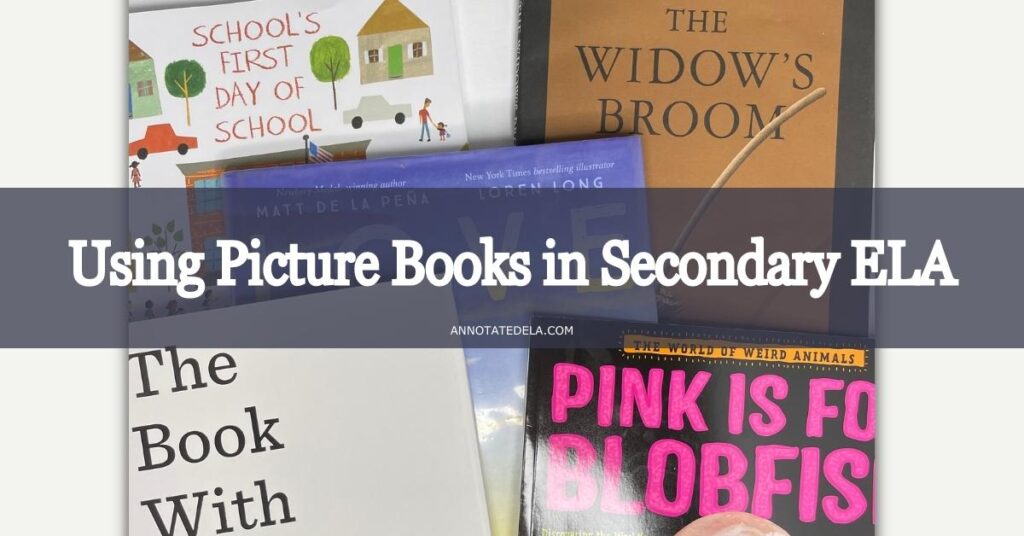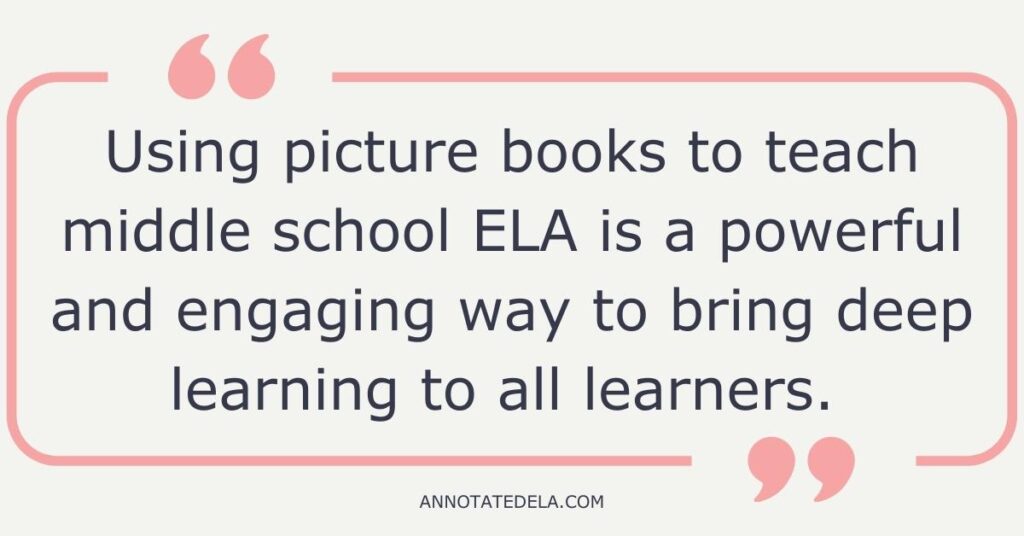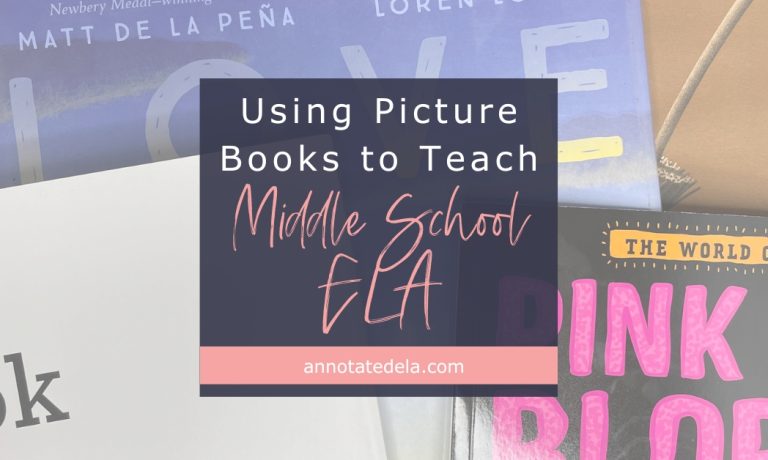In the ever-evolving landscape of education, teachers are always looking for innovative methods to engage their students; using picture books to teach middle school ELA is one way to cultivate a deep appreciation for reading and writing. Picture books are associated with elementary education. However, picture books are a hidden gem for engaging and inspiring middle school students.
Beyond their colorful illustrations and simple narratives, picture books offer many benefits that make them invaluable in middle school ELA instruction.
This article will explore the many advantages of using picture books to teach middle school ELA.
Why Use Picture Books in the Classroom?
- Students think picture books are less intimidating than novels or even short stories. Students can progress through the story in one sitting and begin practicing reading and writing skills.
- Picture books also engage all students, including reluctant readers. Picture books are bite-sized literature that allows for deep teaching and learning in a fun and engaging way.
- Picture books can spark conversation among students.
- Picture books can also be a scaffold to more complex text and analysis of those texts and practice for comprehension strategies.
- Practice asking questions. Students can practice levels of questioning and think more critically about a piece of writing.
- The pure enjoyment of reading and literature.
Finally, there are many reasons to use picture books with your secondary students, so get started and see what happens.

Ways to Use Picture Books in the Classroom
Introducing elements of the writer’s craft – picture books can be a great way to teach a specific technique. Students view picture books as less threatening and feel confident in their ability to analyze these “simple” stories. After students have analyzed the craft, they can transfer their knowledge to their writing.
Literary Analysis – picture books are less intimidating, so students feel confident and can practice analysis skills. For example, analyzing character motivation or identifying and evaluating themes are ways to use picture books.
Scaffolding – picture books are a scaffold for a new skill that can later be applied to longer, more challenging text will build skills and confidence. Teach the mini-lesson on the skill and then have students work together to practice the skill with picture books.
Supplemental text – picture books are perfect supplements to what is already being read in class—many nonfiction. Picture books, poetry books, and fiction picture books will fit any skill or genre.
Picture books build community – students love being read to, no matter their age. There is rarely enough time to stop and enjoy a read aloud with our students, but picture books can make that magical moment happen. Reading to our students is a time to stop and come together as a classroom community.
Picture books can build confidence – there are always students who claim to not be good at reading or writing; or to not like reading or writing. Picture books are accessible and there are books about writing and reading, after all picture books are meant to teach a lesson. Let students connect with authors who may not have liked reading or writing.
Discussion – this goes with community and confidence because students often won’t talk or share in class for several reasons. Some of those reasons might be that they are not engaged, they are shy, or they don’t want to be wrong. Picture books are a way to engage students, teach lessons about being shy, and through confidence building students may be more likely to share their thoughts.

Using Picture Books to Teach Specific Topics
Generally speaking, picture books are most commonly used to teach specific topics and elements of literature and/or writing. Here are some ideas on what to teach and which books to use.
- Theme: This always gets students. They are masters at identifying topics, but the theme becomes tricky. Pictures books are a great way to present and practice difficult topics in a low stakes way. Try Tracy Ludwig’s The Invisible Boy
- Personification: Personifying animals is one of the most common forms of personification, so I was excited to find School’s First Day of School by Adam Rex. Breaking away from animals helps students see what else can be personified.
- Point of View: is a powerful writing tool and helping students understand and harness the power is important. There are many books that showcase point of view, but some of my favorites are the mixed up fairy tales. Check out The True Story of the Three Little Pigs by Jon Scieszka and Seriously Cinderella is so Annoying by Trisha Speed Shaskan. There are many other books to use; these books help students see how a story changes based on point of view.
- Figurative language: to include simile, metaphor, rhyme, repetition, etc. Science Verse and Math Curse by Jon Scieszka are fun poetry books.
- Transitions: are important for guiding the reader and connecting ideas, and showing students how they can be used is even more important. Chris VanAllsburg’s The Witch’s Broom is a sweet story with clear examples of narrative transitions.
- Symbolism: The Snowy Day by Ezra Jack Keats follows a young boy’s adventures in the snow, and it can be used to discuss the symbolism of snow and the changing seasons. Also check out Love by Matt De La Peña.
- Word Choice: Choosing “just right” words seems to be lost on so many of my middle school students. My guess is that they don’t have the vocabulary to choose words that are specific and paint a picture. Vocabulary is a whole other post! A book that is fun and showcases the importance of words is, The Book with No Pictures by BJ Novak. It is fun to read and gets everyone feeling silly!
- Main idea/central idea: Get students to read nonfiction and identify main idea. Pink is for Blobfish by Jess Keating is a nonfiction picture book with many fun facts.
- Inference: Wordless picture books are the perfect fit! The Lion and The Mouse by Jerry Pinkney is a wordless picture book that retells the classic Aesop fable. This book emphasizes kindness and the symbolism of small acts having significant impacts.

Let’s recap. There are so many ways to use picture books in your secondary classroom. Using picture books to teach middle school ELA is an engaging way to bring deep learning to all learners.



